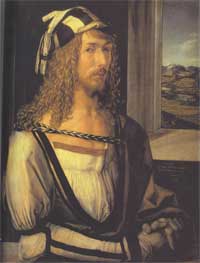Albrecht Dürer - Biography in Brief
Albrecht Dürer, the second son of Albrecht Dürer the Elder and Barbara Holper, was born in Nuremberg on 21 May 1471.
 Self-Portrait, 1498 Museo del Prado, Madrid |
Albrecht Dürer - BiographyBorn: 1471 A.D. - NurembergDied: 1528 A.D. - NurembergEarly YearsWanderjahre The Marriage Return to Nuremberg In Venice 1507 - 1520 In The Netherlands Last Years |
As a young boy, he started to learn the goldsmith's craft in his father workshop, however he was more inclined towards painting. Seeing his talent, his father yielded to his son wish and the young Albrecht became an apprentice of the painter Michael Wolgemut. After three years of learning, in 1490 he left for his Wanderjahre.
In 1494, Albrecht Dürer returned to Nuremberg, where he married Agnes Frey. In the same year, Dürer was accepted as a member of the painters’ guild of Nuremberg, and in autumn he left for Venice alone.
He returned from Italy in the spring of 1495. Between 1496 and 1498, he created the fifteen large woodcuts of the Apocalypse.
Dürer's father died in 1502, and Albrecht recorded his last moments, noting that his father died like a Christian, after receiving the Holy Sacrament.
In the second half of 1505, Dürer set for his second journey to Venice. There were probably pecuniary reasons behind his decision to leave for Italy. Nuremberg did not pay his artists very well. Besides, he could extend his circle of friends, and make himself known beyond the limited society of his native city. Indeed, in Venice for the first time, he was appreciated at his true value, and important people of Venice and artists alike were eager to meet him.
The Venetian Senate even offered him a pension of two hundred ducats if he would stay in Venice. However, the Venetian painters were not too happy with his presence there, except Giovanni Bellini. Reluctantly, the artist returned to Nuremberg in 1507.
Albrecht Dürer's biography is harder to trace between 1507-1520, as he did not leave any account regarding his private life between these years. However, the high number of works belonging to this period is indicating intense, hard work. It appears that between 1512 and 1516, Durer's activity as a painter ceased for some time and he devoted himself to making engravings and woodcuts.
In 1514 Dürer experienced the great sorrow of losing his mother, who died May 17th, after a long and painful illness.
On July 12th, 1520, Dürer set for Netherlands, accompanied by his wife and a maid.
He went to Cologne and then to Antwerp, visiting Aix-la-Chapelle, Ghent and Bruges. While in Antwerp, he witnessed the coronation of Emperor of Charles V. During the journey, he made sketches of people and cities, buildings and animals.
The festivities and his work did not prevent the artist to keep a close eye on the religious turmoil caused by the Lutheran movement in Germany, and he expressed his support for the leader of the Reform. In the following summer the painter returned to Nuremberg.
In 1525, he published an important scientific work, "The Teaching of Measurements with Rule and Compass."
In 1526, Dürer created his last great painting work, the "Four Apostles," his gift for the City of Nuremberg Council. In 1527, he published his "Art of Fortification. “ Another large work, the four-volume "Human Proportions," was in preparation to be printed when the artist died suddenly on April 6th, 1528.
Albrecht Dürer was mourned by all the great minds of the time, and his death was truly regarded as a huge loss, not only for Germany, but for all Europe, and the mankind.

